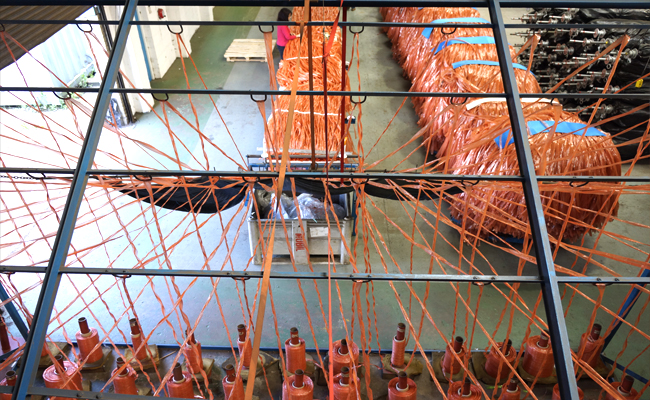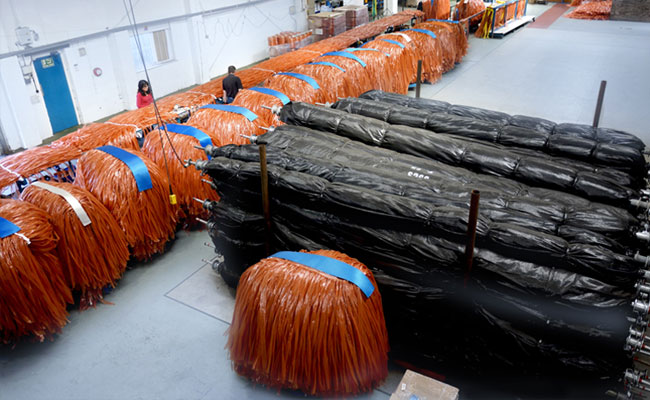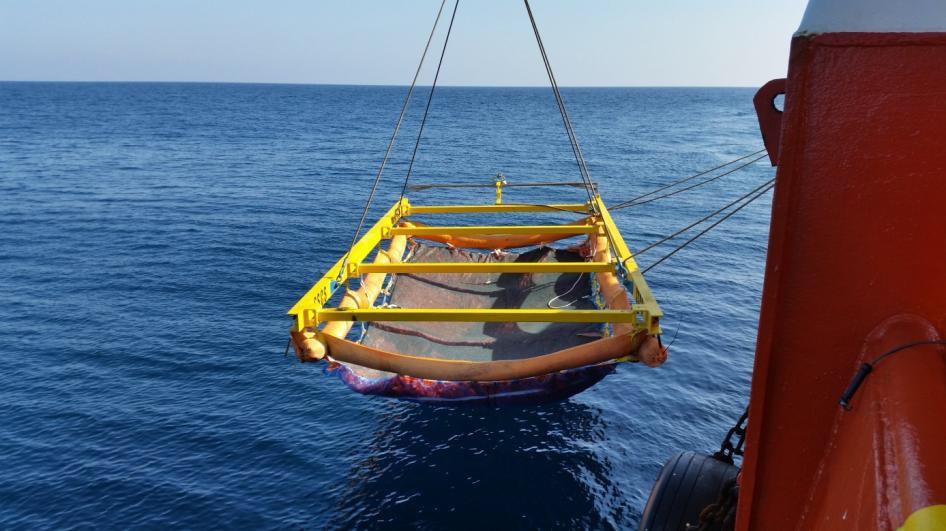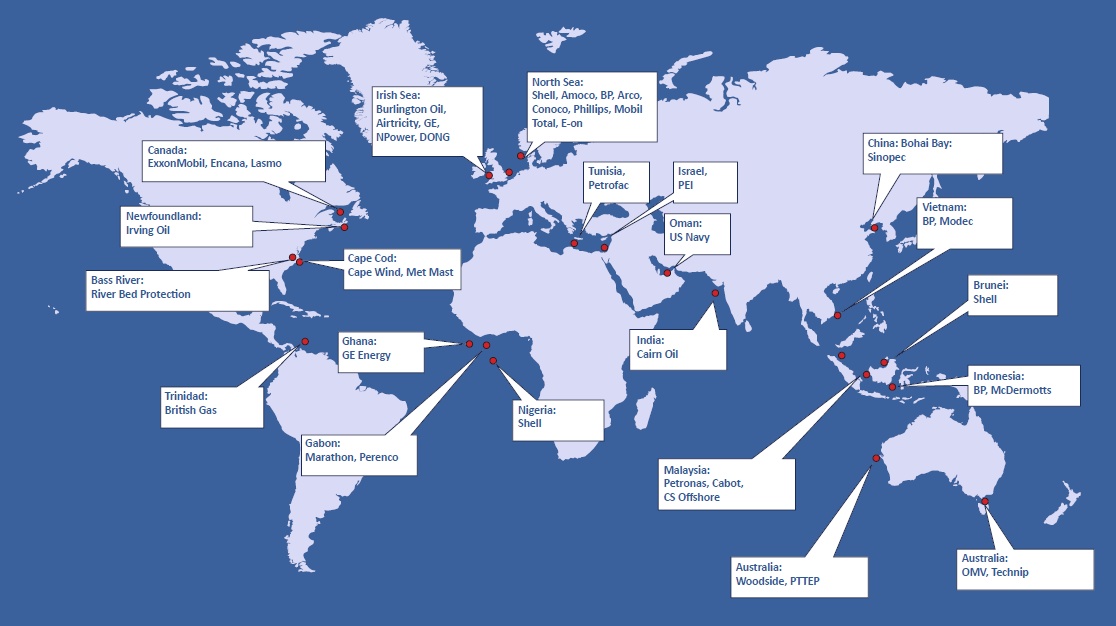Scour Control Products
The SSCS Frond Mats are used to provide planned and preventative scour protection for new subsea installations and to rectify scour encountered at existing facilties and provide the only permanent solution to scour available today.
SSCS has been approved to ISO 9001 2008 by Lloyds Register Quality Assurance Ltd. The SSCS Frond Mats have also received DNV approval for use at Offshore Wind Farm sites.
Manufacture
We design and manufacture Frond Mats at our UK base for all types of subsea foundations, cables, pipelines, templates and platforms. Our system is an effective way of protecting structures, whilst protecting natural habitats and attracting sea living plants and life

Experience
With over 30 years experience our Frond solutions are designed by our own engineers and based on real life experience of use in the field.
With the first SSCS Frond Mats being installed in the Southern North Sea in 1984 remaining in place today and requiring no maintenance since being deployed, we are confident that we can provide a permanent solution for your scour prevention or rectification requirement.
View our Worldwide Locations map below for more information on some of our global projects.

System
The SSCS Frond System comprises continuous lines of overlapping buoyant polypropylene Fronds that, when activated, create a viscous drag barrier that significantly reduces current velocity. The frond lines are secured to a polyester webbing mesh base that is itself secured to the seabed by a weighted perimeter or anchors pre-attached to the mesh base by polyester webbing lines.
The action of reducing current velocity immediately prevents seabed sediment in the immediate area of the Fronds from being transported i.e. ‘scoured out’, and causes sediment transported across the Fronded area to fall into, and collect, within the fronds.
We hold stock of two standard types of Frond Mat: Anchor Retained Frond Mats which are held into position by a series of anchors which are driven into the seabed or riverbed by divers; and Weighted Frond Mats which are held into position by weighted edges around the perimeter of the Mat and are installed using an SSCS Installation Frame removing the necessity for diver intervention.
Installation
Our standard Mat installation options keep the process unique any easy to install. We have developed anchor systems which can be installed with or without ROV or diver supervision depending on project requirements and site conditions.
As the Mats are fully adaptable they can also be designed for client specified installation methods including pre-attachment to subsea structures, for example.
The Installation Procedures for the SSCS standard stock Mats are available from the following links:
SSCS Weighted Frond Mat Installation Procedures

Natural Habitat
Our Frond Mats have been found in various studies to be beneficial not only to subsea structures but also the natural habitat. Once established, within a very short time the Fronded area becomes the perfect home for a variety of sea creatures.

Technical
Frond Scour Control Mats
The SSCS Frond Mats are manufactured in the following standard sizes:
Anchor Retained Frond Mats:
• Type 12 – 5m x 2.5m c/w 8 Anchors
• Type 25 – 5m x 5m c/w 16 Anchors
Weighted Frond Mats:
• 5m x 2.5m
(All our Frond Mats have 1.25m high fronds as a standard, however these can be reduced to suit site specific requirements)
Specially designed Mats can also be manufactured to meet requirements such as defined structural geometrical arrangements, to enable accessibility at sites otherwise deemed inaccessible and to meet the demands of extreme environmental conditions.
Download - Specification Sheet
SSCS Unique Frond Pin & Anchor System
Scour Control Engineering and Consultancy Services
• Desk Top Review and Analysis of Site Survey Data.
• Assessment of Site Scour Susceptibility.
• Scour Protection and Rectification Recommendations.
• Design of Frond Scour Protection and Rectification Systems
• Environmental Studies
• Frond System Installation Supervision
• Frond Mat Installation Procedures
• Specially Designed Frond Systems
Scour Assessment Studies
These can incorporate an analysis of Site Soils and Metocean conditions, a determination of the Site Susceptibility to Scour, the extent and rate of Scour development, its impact on planned and existing subsea installations and recommendations for Scour Rectification and Permanent Scour Protection.
Download - Site Scour Study Information
Worldwide Locations

The above are our approx. project locations plotted on a map, if you would like to find out more about our Projects please visit our Projects Page.
What is Scour
The Cause of Scour
Seabed soil types and a combination of current, tidal and wave forces combine to create an environment which leads to seabed sediment being lifted and transported.
The result is the natural depletion of soil in one area and its aggradation in another.
This natural occurrence known as scour, or erosion, is exacerbated when objects are placed on the seabed, such as pipelines, platforms, protection structures, umbilicals and cables.
Any fixed subsea installation will disrupt tidal flow, causing the current to first decelerate in advance of it then accelerate beyond it, to form vortices and eddies which cause sediment to be scoured, i.e. lifted from the seabed and transported.
Local Scour
Any fixed subsea installation will disrupt tidal flow, causing the current to first decelerate in advance of it then accelerate beyond it, to form vortices and eddies which cause sediment to be scoured, i.e. lifted from the seabed and transported.
Reversed tidal flows will cause scour to develop significantly on all sides of the installation to form steep sided scour pits, and in the case of pipelines, cables and umbilicals, beneath them, to cause free spanning.
Global Scour
Shallower ripples and wider depressions can also form beneath and extend to some distance from the installation. This is referred to as global scour and can impact on an individual installation or form through interaction between adjacent installations.
How the SSCS Frond System Works
Frond System
The SSCS Frond System comprises continuous lines of overlapping buoyant polypropylene fronds that when activated create a viscous drag barrier that significantly reduces current velocity. The frond lines are secured to a polyester webbing mesh base that is itself secured to the seabed by anchors pre-attached to the mesh base by polyester webbing lines.
The action of reducing current velocity immediately prevents seabed sediment in the immediate area of the fronds from being transported i.e. ‘scoured out’, and causes sediment transported across the fronded area to fall into, and collect, within the fronds.
Prevention
By reducing current flow the SSCS Frond Systems prevent scour from occurring and rectify scour by reversing the effects that cause it.
A planned and selective deployment of the Frond Systems will immediately prevent and remedy scour, and provide permanent scour protection.
Step by Step
The following photographs, courtesy of Shell UK Exploration & Production Ltd prove and demonstrate the effectiveness of the SSCS Frond Systems. The originally installed Frond Mats have now been in place at this Shell site for some 23 years and continue to provide protection.
The above CGI video demonstrates how the SSCS Frond Mats prevent scour permanently and the installation methods for the Frond Mats we hold in stock.
Benefits Of The Frond System
Eliminates scour immediately upon installation
Once activated the SSCS Frond Systems immediately create viscous drag and reduce current velocity and turbulence at the installation site eliminating both the conditions which create scour and the mass transportation of sediment.
Provides a permanent, maintenance free solution to scour
The Frond Systems offer an immediate and effective “soft” solution, in that they are environmentally approved and do not present the hard, hydro-dynamically unstable, edge presented by other methods and therefore do not create edge scour.
Other methods such as rock dumping and/or the deployment of sand/gravel bags alone and concrete only mattresses only, increase the profile of the structure, pipeline or cable and create edge scour which results in settlement, sinkage, costly maintenance, and secondary scour.
Rock has been found to sink to the first impermeable layer in the seabed; that sand and grout bags alone have been washed away; and that concrete only mattresses have been both washed away and left suspended on, or at, the installation they were intended to protect.
Provides dropped object and impact protection
Impact loads are dissipated throughout the progressively reinforced energy absorbing sediment bank which forms in the fronds and which, compacted by tidal flow during its formation, is more dense than the surrounding seabed.
Can be installed with relative ease and speed
The installation time for each Frond Mat is approx: 20 minutes from deployment at the surface to completion of installation on the seabed.
The Frond Systems have been installed by all major diving installation contractors. Therefore diver installation experience and competence is well established.
Have low installed costs
Installation of the SSCS Frond Mats can be carried out from a relatively inexpensive support vessel ,while the Fronded Concrete Mattresses can be installed either with diver assistance or with the use of a competent work class ROV. The costs of installation of both Systems are considerably lower than those associated with other methods.
Are environmentally approved
The sediment sandbank contours flow and blend into the seabed in a hydro-dynamically acceptable shape and can create a Natural Habitat for Marine Life.
Envrionmental Approval
All Scour Control Systems designed, manufactured and supplied by SSCS are proven to be environmentally acceptable, and have been installed in the some of the most environmentally sensitive locations in the world.
They were judged in 1996 to be:
“Environmentally acceptable – the sandbank contours follow and blend into the river or seabed, and does not affect marine life or vegetable growth or fishing”
~ Dr Krystian W. Pilarczyk, Road and Hydraulic Engineering Division, Rijkswaterstaat, Delft
& Dr Ryszard B. Zeidler, Institute of Hydro-Engineering, Polish Academy of Sciences
SSCS has received the full approval for the use and deployment of its Frond Systems from:
• DEFRA (Department for Environment, Food and Rural Affairs)
• CEFAS (Centre for Environment, Fisheries and Aquaculture Science)
• US Corps of Engineers
• British National Federation of Fisherman’s Organisations
• Hydraulic Engineering Division, Rijkswaterstaat, Netherlands
• Institute of Hydro-Engineering, Polish Academy of Sciences
• DNV (Det Norske Veritas)
• Lloyds Register Quality Assurance
• COWI / OCC
• the major Oil and Gas Exploration & Development Companies
• the Renewables Energy Industry
For copies of current certificates or for any information please contact us directly





